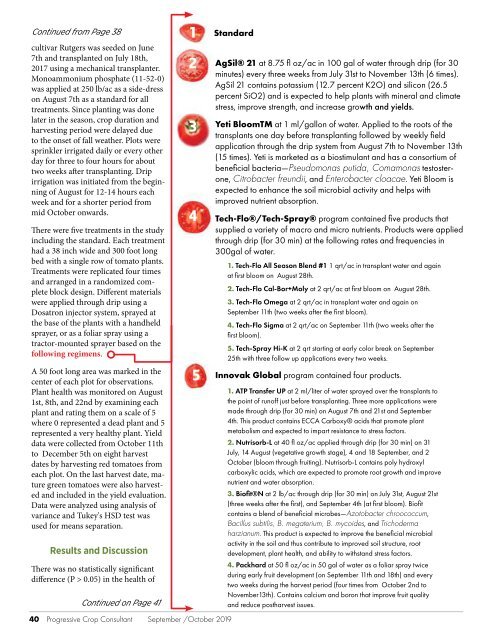PCC Sep Oct 2019
Create successful ePaper yourself
Turn your PDF publications into a flip-book with our unique Google optimized e-Paper software.
Continued from Page 38<br />
cultivar Rutgers was seeded on June<br />
7th and transplanted on July 18th,<br />
2017 using a mechanical transplanter.<br />
Monoammonium phosphate (11-52-0)<br />
was applied at 250 lb/ac as a side-dress<br />
on August 7th as a standard for all<br />
treatments. Since planting was done<br />
later in the season, crop duration and<br />
harvesting period were delayed due<br />
to the onset of fall weather. Plots were<br />
sprinkler irrigated daily or every other<br />
day for three to four hours for about<br />
two weeks after transplanting. Drip<br />
irrigation was initiated from the beginning<br />
of August for 12-14 hours each<br />
week and for a shorter period from<br />
mid <strong>Oct</strong>ober onwards.<br />
There were five treatments in the study<br />
including the standard. Each treatment<br />
had a 38 inch wide and 300 foot long<br />
bed with a single row of tomato plants.<br />
Treatments were replicated four times<br />
and arranged in a randomized complete<br />
block design. Different materials<br />
were applied through drip using a<br />
Dosatron injector system, sprayed at<br />
the base of the plants with a handheld<br />
sprayer, or as a foliar spray using a<br />
tractor-mounted sprayer based on the<br />
following regimens.<br />
A 50 foot long area was marked in the<br />
center of each plot for observations.<br />
Plant health was monitored on August<br />
1st, 8th, and 22nd by examining each<br />
plant and rating them on a scale of 5<br />
where 0 represented a dead plant and 5<br />
represented a very healthy plant. Yield<br />
data were collected from <strong>Oct</strong>ober 11th<br />
to December 5th on eight harvest<br />
dates by harvesting red tomatoes from<br />
each plot. On the last harvest date, mature<br />
green tomatoes were also harvested<br />
and included in the yield evaluation.<br />
Data were analyzed using analysis of<br />
variance and Tukey's HSD test was<br />
used for means separation.<br />
Results and Discussion<br />
There was no statistically significant<br />
difference (P > 0.05) in the health of<br />
Continued on Page 41<br />
40 Progressive Crop Consultant <strong>Sep</strong>tember /<strong>Oct</strong>ober <strong>2019</strong><br />
1<br />
2<br />
3<br />
4<br />
5<br />
Standard<br />
AgSil® 21 at 8.75 fl oz/ac in 100 gal of water through drip (for 30<br />
minutes) every three weeks from July 31st to November 13th (6 times).<br />
AgSil 21 contains potassium (12.7 percent K2O) and silicon (26.5<br />
percent SiO2) and is expected to help plants with mineral and climate<br />
stress, improve strength, and increase growth and yields.<br />
Yeti BloomTM at 1 ml/gallon of water. Applied to the roots of the<br />
transplants one day before transplanting followed by weekly field<br />
application through the drip system from August 7th to November 13th<br />
(15 times). Yeti is marketed as a biostimulant and has a consortium of<br />
beneficial bacteria—Pseudomonas putida, Comamonas testosterone,<br />
Citrobacter freundii, and Enterobacter cloacae. Yeti Bloom is<br />
expected to enhance the soil microbial activity and helps with<br />
improved nutrient absorption.<br />
Tech-Flo®/Tech-Spray® program contained five products that<br />
supplied a variety of macro and micro nutrients. Products were applied<br />
through drip (for 30 min) at the following rates and frequencies in<br />
300gal of water.<br />
1. Tech-Flo All Season Blend #1 1 qrt/ac in transplant water and again<br />
at first bloom on August 28th.<br />
2. Tech-Flo Cal-Bor+Moly at 2 qrt/ac at first bloom on August 28th.<br />
3. Tech-Flo Omega at 2 qrt/ac in transplant water and again on<br />
<strong>Sep</strong>tember 11th (two weeks after the first bloom).<br />
4. Tech-Flo Sigma at 2 qrt/ac on <strong>Sep</strong>tember 11th (two weeks after the<br />
first bloom).<br />
5. Tech-Spray Hi-K at 2 qrt starting at early color break on <strong>Sep</strong>tember<br />
25th with three follow up applications every two weeks.<br />
Innovak Global program contained four products.<br />
1. ATP Transfer UP at 2 ml/liter of water sprayed over the transplants to<br />
the point of runoff just before transplanting. Three more applications were<br />
made through drip (for 30 min) on August 7th and 21st and <strong>Sep</strong>tember<br />
4th. This product contains ECCA Carboxy® acids that promote plant<br />
metabolism and expected to impart resistance to stress factors.<br />
2. Nutrisorb-L at 40 fl oz/ac applied through drip (for 30 min) on 31<br />
July, 14 August (vegetative growth stage), 4 and 18 <strong>Sep</strong>tember, and 2<br />
<strong>Oct</strong>ober (bloom through fruiting). Nutrisorb-L contains poly hydroxyl<br />
carboxylic acids, which are expected to promote root growth and improve<br />
nutrient and water absorption.<br />
3. Biofit®N at 2 lb/ac through drip (for 30 min) on July 31st, August 21st<br />
(three weeks after the first), and <strong>Sep</strong>tember 4th (at first bloom). Biofit<br />
contains a blend of beneficial microbes—Azotobacter chroococcum,<br />
Bacillus subtilis, B. megaterium, B. mycoides, and Trichoderma<br />
harzianum. This product is expected to improve the beneficial microbial<br />
activity in the soil and thus contribute to improved soil structure, root<br />
development, plant health, and ability to withstand stress factors.<br />
4. Packhard at 50 fl oz/ac in 50 gal of water as a foliar spray twice<br />
during early fruit development (on <strong>Sep</strong>tember 11th and 18th) and every<br />
two weeks during the harvest period (four times from <strong>Oct</strong>ober 2nd to<br />
November13th). Contains calcium and boron that improve fruit quality<br />
and reduce postharvest issues.


















